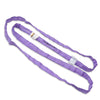Why Web Slings Are So Useful
Web slings are particularly valued for their ability to distribute weight evenly over a wide surface area. This makes them an excellent choice for lifting items that are easily damaged by pressure points—think of lifting large, fragile items like glass or sensitive equipment that can’t tolerate heavy, concentrated force.
For example, if you're tasked with lifting a massive, irregularly shaped machine component weighing several tons, chains or steel slings could cause damage due to high pressure at contact points. A polyester web sling offers a wide bearing surface that distributes the load and protects delicate surfaces. This flexibility makes web slings a go-to solution in industries like manufacturing, construction, and shipping.
What Causes Wear and Damage to Web Slings?
Despite their durability, web slings can suffer damage, especially when used improperly or exposed to harsh conditions. Here are the primary causes:
-
Abrasion
Web slings often encounter rough or sharp surfaces, leading to friction that wears down fibers. Dragging a sling or rubbing it against sharp edges can cause abrasion.
-
Cuts and Tears
Cuts and tears, especially from sharp corners, drastically reduce the working load limit (WLL) and can cause sling failure.
-
UV Degradation
Ultraviolet (UV) light exposure degrades synthetic sling fibers over time, weakening them even without visible damage.
-
Chemical Exposure
Chemicals like acids and solvents can break down sling fibers. Knowing your sling’s exposure risk is essential.
-
Heat Damage
Excessive heat can melt or deform synthetic fibers, particularly near welders or furnaces.
-
Overloading and Shock Loading
Exceeding the rated load or sudden shocks weakens fibers and can cause failure.
Remedies: How to Combat Wear and Tear
Many remedies are affordable and easy to implement. Here are some effective strategies:
-
Proper Storage
Cost: Low | Convenience: High
Store slings in a cool, dry area away from sunlight, chemicals, and moisture.
-
Regular Inspections
Cost: Low | Convenience: High
Check for fraying, cuts, or discoloration. Remove damaged slings immediately.
-
Edge Protectors or Wear Pads
Cost: Low to Moderate | Convenience: High
Use protectors to prevent cuts and abrasion.
-
Proper Sling Configuration
Cost: Low to Moderate | Convenience: Moderate
Ensure correct configurations and load angles to avoid uneven wear.
-
Sling Sleeves and Covers
Cost: Moderate | Convenience: High
Protects webbing from damage and can be reused.
-
Use Task-Specific Slings
Cost: High | Convenience: Moderate
For harsh conditions, consider specialized materials like Kevlar.
Maximizing Web Sling Longevity
Web slings offer strength and flexibility but can suffer from wear and tear. By storing slings properly, inspecting them regularly, and using protective tools, you can extend their lifespan and ensure safe lifting.
For more details on web sling safety, visit E-Rigging’s Web Slings Warnings & Instructions page.





